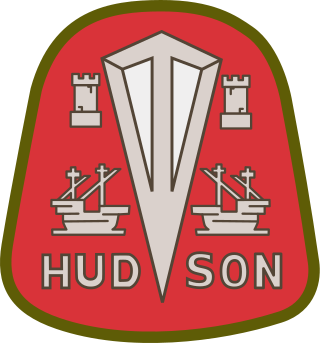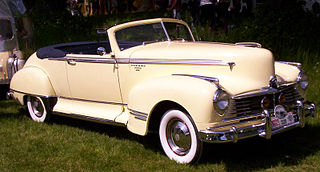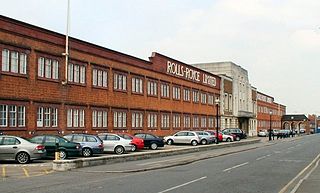Biddle and Smart was a manufacturer of carriages and then automobile bodies based in Amesbury, Massachusetts. It started as a successful carriage manufacturer before making the transition to auto body manufacturer in 1905.
Biddle and Smart was a manufacturer of carriages and then automobile bodies based in Amesbury, Massachusetts. It started as a successful carriage manufacturer before making the transition to auto body manufacturer in 1905.
The town of Amesbury, Massachusetts, was a centre of carriage-making. [1] Biddle and Smart began trading either in 1870 [2] or 1880. [3] An almost-contemporary source says that The Biddle, Smart Carriage Co. was formed by William E. Biddle, William W. Smart, and M. D. F. Steeve in 1878 and began production two years later. [4]
In 1905, [3] Biddle and Smart became one of the first carriagemakers in Amesbury to begin the manufacture of automobile bodies. [1] An early customer was the Club Car Company of New York City and from 1910 to 1911, the firm was the builder of Club’s cars. In 1917 Biddle and Smart purchased the factory of S.R. Bailey & Co., allowing greater production.
By the early 1920s customers included Hudson, for whom they began making closed bodies in 1923. From 1923 the company became the exclusive producer of car bodies for Hudson, a turning point that would see production triple with 12,000 bodies manufactured in 1923. With expansion Biddle and Smart acquired a number of local coachbuilders, including Currier Cameron & Co., Hollander & Morrill Body Co., Witham Body Co., T. W. Lane Company, Auto Body & Finishing Co., and Bryant Body Co. This brought the total space to nearly a half million square feet in 21 buildings in six different sections of town.
In 1925, Biddle & Smart began making bodies for Rolls-Royce of America at Springfield, Massachusetts. The company had fulfilled a small order for Rolls-Royce previously in 1919.
In May 1925, Hudson introduced the Biddle & Smart-built Brougham, a closed-coupled four-door sedan with blind rear quarters covered, as was the entire roof in black leather. The Brougham was an immediate success and was continued into 1926 and 1927 with some modifications.
In addition to Hudson and Rolls-Royce, Biddle and Smart also built bodies for Lincoln, Peerless, Marmon, Mercer, White, Chalmers, Speedwell and Haynes. [5]
By March 1926 its Amesbury holdings had grown from nine shops to 41 shops and the output had grown to 400 bodies manufactured a day. Peak shipments came in 1926 when the firm delivered 41,000 bodies to Hudson. An inability to stamp steel meant that their products were made using aluminium. [3]
In 1926 Hudson opened a brand new 10 million dollar body plant in Detroit. By the end of 1926 all steel-bodied Hudsons were being built at the new plant, and because of the inability of Biddle and Smart to produce steel bodies, production for Hudson dropped by 60%.
Hudson continued with the aluminum bodies from Biddle and Smart, advertising them as "custom-built" bodies even though they were exactly the same as the steel body models built at the Hudson factory. Hudson produced a range of cars designed by Walter M. Murphy Co. of Pasadena, California after 1927 and these were built by Biddle and Smart, advertised as "Design by Murphy." Production continued until 1929. 10 Hudson body styles were sold in 1929 with Biddle and Smart producing two, Detroit-based Briggs Manufacturing Company producing three, and Hudson producing the other five models inhouse.
At the end of December 1929 Hudson declined to renew its yearly contract. The beginning of the Great Depression saw car prices decline and transport costs from Massachusetts to Detroit become cost prohibitive. Hudson had to resort to local producers such as Briggs Manufacturing Co.
1930 was the last year of Biddle and Smart production for Hudson, leaving the company with no customers by the end of the year. After a failed attempt at marketing aluminum boats the company went out of business in 1930. [2]

The Cadillac Motor Car Division is a division of the American automobile manufacturer General Motors (GM) that designs and builds luxury vehicles. Its major markets are the United States, Canada and China. Cadillac models are distributed in 34 additional markets worldwide. Historically, Cadillac automobiles were at the top of the luxury field within the United States, but have been outsold by European luxury brands including BMW and Mercedes since the 2000s. In 2019, Cadillac sold 390,458 vehicles worldwide, a record for the brand.

The Hudson Motor Car Company made Hudson and other branded automobiles in Detroit, Michigan, U.S., from 1909 until 1954. In 1954, Hudson merged with Nash-Kelvinator to form American Motors Corporation (AMC). The Hudson name was continued through the 1957 model year, after which it was discontinued.

Auburn was a brand name of American automobiles produced from 1900 to 1937, most known for the Auburn Speedster models it produced, which were fast, good-looking and expensive. However, after the 1929 Wall Street Crash, and the economic downturn that ensued, Auburn's expensive automobiles, along with its also very expensive sister marques Duesenberg and Cord, saw inevitable sales downturns, and all vehicle business halted in 1937.

The Dort Motor Car Company of Flint, Michigan, built automobiles from 1915 to 1924.

Fisher Body was an automobile coachbuilder founded by the Fisher brothers in 1908 in Detroit, Michigan.

A coachbuilder or body-maker is a person or company who manufactures bodies for passenger-carrying vehicles. Coachwork is the body of an automobile, bus, horse-drawn carriage, or railway carriage. The word "coach" was derived from the Hungarian town of Kocs. A vehicle body constructed by a coachbuilder may be called a "coachbuilt body" or "custom body".

The Hudson Commodore is an automobile that was produced by the Hudson Motor Car Company of Detroit, Michigan between 1941 and 1952. During its time in production, the Commodore was the largest and most luxurious Hudson model.

Brewster & Company was an American custom carriage and motor coachbuilder, James Brewster established the company in 1810; it operated for approximately 130 years. Brewster got its start in New Haven, Connecticut, and quickly gained a reputation for producing the best carriages in the country. In 1827, he set his shop at 52 Broad Street in New York City.

Barley Motor Car Co. was a manufacturer of luxury automobiles in Kalamazoo, Michigan, and Streator, Illinois. It manufactured the Roamer automobile (1916–29) and briefly, the Barley (1922–24), and the Pennant (1924–25).

Pressed Steel Company Limited was a British car body manufacturing business founded at Cowley near Oxford in 1926 as a joint venture between William Morris, Budd Corporation of Philadelphia USA, which held the controlling interest, and a British / American bank J. Henry Schroder & Co. At that time the company was named The Pressed Steel Company of Great Britain Limited. It acquired Budd's patent rights and processes for use in the United Kingdom. Morris transferred his interest to his company, Morris Motors Limited.

Rolls-Royce Limited was a British luxury car and later an aero-engine manufacturing business established in 1904 in Manchester by the partnership of Charles Rolls and Henry Royce. Building on Royce's good reputation established with his cranes, they quickly developed a reputation for superior engineering by manufacturing the "best car in the world". The business was incorporated as "Rolls-Royce Limited" in 1906, and a new factory in Derby was opened in 1908. The First World War brought the company into manufacturing aero-engines. Joint development of jet engines began in 1940, and they entered production in 1944. Rolls-Royce has since built an enduring reputation for the development and manufacturing of engines for military and commercial aircraft.

James Young Limited was a top class British coachbuilding business in London Road, Bromley, England.

The Hudson Super Six Coach is an automobile which was first manufactured by the Hudson Motor Car Company of Detroit, Michigan in 1916. The first model was kept in production until 1928. The nameplate was revived for a rebadged Essex for 1933, and then returned again from 1940 until 1951, aside from a wartime hiatus. The 1951s were actually called "Hudson Super Custom Six".

The Rauch & Lang Carriage Company was an American electric automobile manufactured in Cleveland, Ohio, from 1905 to 1920 and Chicopee Falls, Massachusetts, from 1920 to 1932.

The Lincoln L series is the first automobile that was produced by the Lincoln Motor Company. Introduced in 1920, the L series would continue to be produced after the bankruptcy of Lincoln in 1922 and its purchase by Ford Motor Company.

The Carlton Carriage Company was a highly respected London coachbuilder that provided bespoke coachwork for some of the finest car makers of the 1920s and 30s. They are best known for their drophead coupes which are archetypal designs of the British Jazz Era.

Carrosserie Vanvooren was a French Coachbuilder based in the north-western Paris suburb of Courbevoie. The company concentrated on producing car bodies for luxury cars, being closely associated, during the 1930s, with the products of Hispano-Suiza, Bugatti, Rolls-Royce and Bentley.
Briggs Manufacturing was an American, Detroit-based manufacturer of automobile bodies for Ford Motor Company, Chrysler Corporation and other U.S. and European automobile manufacturers.
The Walker Body Company, a former carriage manufacturer based in Amesbury, Massachusetts, began manufacturing metal automobile bodies in 1911. It went bankrupt in 1930. The manufacturing site remains as the Walker Body Company Factory.

S.R. Bailey & Company was an American manufacturer of electric automobiles from 1905 until 1916. They were based in Amesbury, Massachusetts, an early capital of automobile manufacture prior to the Great Depression.